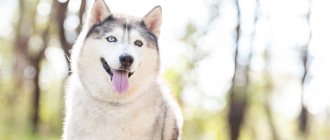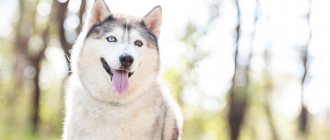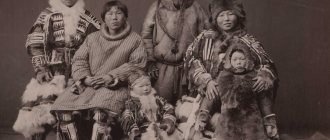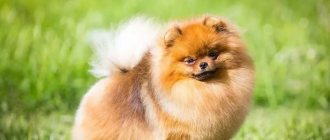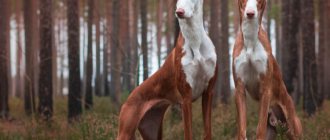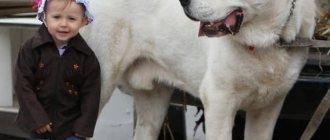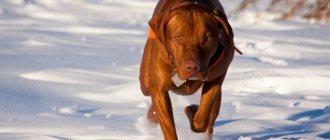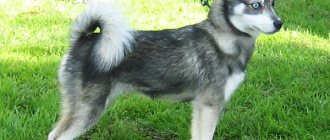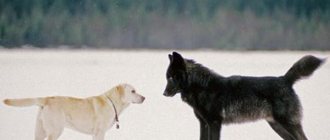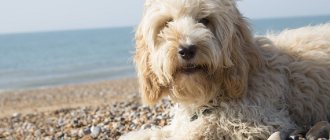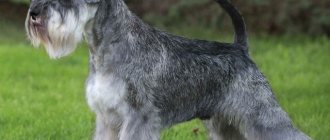Siberian Husky
- Height: from 50 to 60 cm
- Weight: from 16 to 27 kg
- Life expectancy: 12 to 15 years
- Temperament: intelligent, sociable, friendly, attentive, gentle, alert
The Siberian Husky is one of the most popular dog breeds and is probably the first thing most people think of when they think of sled dogs. This medium-sized dog is extremely strong and resilient. A Siberian husky team once traveled more than 1,000 km across the snowy expanses of Alaska to deliver medicine to sick children, and was able to do it in just five and a half days. These dogs are also friendly and love to be around children.
Origin and characteristics of northern sled dog breeds
The fossil dog of Inozemtsev, whose remains were discovered near Lake Ladoga, is considered to be the forerunner of northern sled dog breeds, and no other group of dogs is more closely related to wolves.
The appearance of sled dogs was formed as a result of natural selection in the conditions of the North; the breed's most valuable working qualities were artificially strengthened by man.
The main purpose of northern sled dogs is to tow loads in the Arctic climate with extremely low temperatures and piercing winds, where the road surface is deep snow or slippery ice. These dogs are distinguished by their great working capacity - the average load on a dog in a sled is 40–50 kg at a speed of 6–7 km/h, while in a day the sled covers a distance of 70–80 km, and the total length of the journey is often close to 300–500 km with minimal rest between runs.
The purpose of northern sled dogs is to tow cargo in the harsh conditions of the Arctic.
Northern sled dogs have a number of common characteristics:
- The physique is strong, lean with powerful bones and muscles; this allows you to endure heavy physical activity. Noteworthy are the especially developed muscles of the front legs, neck, chest and back.
- The body format is elongated, the height at the withers is less than the length of the body, which reflects the dog’s ability to run for a long time and relatively quickly. The height of the dog at the withers is usually 1–2 cm greater than the height at the sacrum, since the front legs are slightly longer than the hind legs.
- The fur is warm, consisting of long, straight and hard guard hair and undercoat, also long and thick. There are no fringes on the tail or feathering on the limbs. The feet of the paws are covered with short and stiff hair, which increases their working area and prevents slipping on ice and rubbing the pads of the toes.
- The teeth are very well developed, especially the canines and premolars, which are used for tearing flesh. The bite is scissor-shaped. The dental system is best adapted to the customary feeding of frozen meat to dogs in the North, and is also closest in structure to wild canines.
- Behavior is calm and balanced. These dogs, adapted for living and working in a pack, do not tolerate loneliness well.
- The typical gait (mode of movement) is trot. It is trotting that allows dogs to quickly pull a load over difficult terrain without becoming exhausted.
- Rare barking. Northern dogs, contrary to prejudices, know how to bark, but the habit of barking was suppressed artificially as a meaningless waste of precious energy, so sled breeds howl or bark with the transition to a howl. When parked sled dogs bark when animals or strangers approach.
- Digging the soil. Sled dogs know how and love to dig. Under natural conditions, they need this skill to roost for the night or to hunt small rodents when parked.
The “donut” tail, so often observed in modern “northerners”, is the result of crossing with commercial huskies in the process of further domestication, while the indigenous northern sled dogs are characterized by “log” tails, like those of a wolf.
Training of a sled dog puppy is carried out both by the owner and by more experienced dogs that are part of the team.
Chinook
- Height: from 53 to 69 cm
- Weight: from 25 to 41 kg
- Life expectancy: 13 to 15 years
- Temperament: friendly, intelligent, alert, calm
The Chinook is an American sled dog that was created by breeders in New Hampshire; she is the official dog of this state. This is a poised and muscular dog, often honey or gold in color.
This is an affectionate and playful pet, ideal for families with children . He also gets along well with other pets and loves to learn new tricks. The Chinook is reserved in the presence of strangers, but will not be aggressive towards them.
Labrador Husky
- Height: from 51 to 71 cm
- Weight: from 27 to 45 kg
- Life expectancy: 10 to 13 years
- Temperament: playful, affectionate, loyal, intelligent, sociable
The Labrador Husky is not a cross between a Labrador Retriever and a Siberian Husky, but is a separate breed. She was bred on the Canadian Labrador Peninsula, after which she was named. It is a medium to large sized dog with the characteristic appearance of a wolf. Here are a few more dogs that look like wolves.
This Spitz sled dog is very friendly and energetic and is well suited for large families with multiple active owners to keep the Labrador Husky busy. This rare breed of dog loves to play and fool around , so having such a pet is always fun.
Sled dog. Breeds of sled dogs. Sled dog training
Today, a large number of people prefer sled dog breeds . This is due to the fact that they are very hardened, strong and active. But in order for sled dogs to remain healthy both emotionally and physically, they require special care.
Canadian Eskimo dog
- Height: from 50 to 70 cm
- Weight: from 18 to 40 kg
- Life expectancy: 10 to 15 years
- Temperament: affectionate, intelligent, caring, loyal, vigilant, brave, persistent
The Canadian Eskimo Dog is a medium-sized dog, comparable in weight to a Siberian Husky. She has a thick double coat and a lot of energy to pull a loaded sled. With a moderate tendency to bark, this pet is pack oriented and well suited for sledding, hiking or camping in cold climates.
IMPORTANT! The Canadian Eskimo Dog gets along well with people, but can be aggressive towards other dogs it meets on its walks.
Kugsha
- Height: from 51 to 69 cm
- Weight: from 27 to 50 kg
- Life expectancy: 12 to 14 years
- Temperament: smart, resilient, curious, playful, stubborn
No official kennel club recognizes the kugsha, so such a pet can be difficult to find. This is a large dog with a wolfish appearance and high intelligence. Most experts recommend this breed only to experienced owners because the kugsha is difficult to train. On the other hand, the Kugshu is moderately sociable, creates a strong bond with family members, and can make an excellent pet for an active owner.
Recognized
FCI recognized breeds include:
- husky;
- Samoyeds;
- Alaskan Malamutes;
- Greenland sled;
- Chukotka sledding
Siberian Husky
Siberian Husky
Sibiryak has a medium size, thick undercoat and dense coat. Its powerful frame allows it to easily transport small loads.
The Siberian Husky is not suitable for city life, as its restless nature and independence become the reasons for the destruction of the apartment.
Prices for puppies start from 20 thousand, reaching up to 50 thousand rubles, depending on the class.
Animals are characterized by:
- friendliness and complete lack of aggression towards people;
- cleanliness, keeping maintenance to a minimum;
- loyalty and gentle disposition.
The pet is prone to escape, so it always tries to undermine or break off the leash.
Samoyed husky
Samoyed Laika
Samoyed Laikas have 3 types of head structure:
- fox;
- wolfish;
- bearish.
According to their living conditions, they are similar to huskies, so they need long walks, a spacious enclosure or a large area of a private house that provides the opportunity for free walking.
Prices for puppies start from 10 thousand, reaching up to 35 thousand rubles, depending on the class.
Animals are characterized by:
- friendliness and complete lack of aggression towards people;
- playfulness, which allows you to maintain a childish disposition right up to gray hair;
- loyalty and gentle disposition.
Do not try to train your pet to be a watchdog. He lacks this skill.
Alaskan Malamute
Alaskan Malamute
Malamutes are among the largest representatives of the section. The parameters of an adult pet reach 64 cm and 43 kg.
Alaskan dogs are not suitable for workaholics, as they require constant attention and long periods of walking. Like other representatives of the breed, they should be kept in a private home, but some breeders can cope in apartment conditions.
Prices for puppies start from 12 thousand, reaching up to 30 thousand rubles, depending on the class.
Animals are characterized by:
- silence (the pet rarely makes a voice by barking);
- good nature and high intelligence, allowing you to easily get along with other pets and quickly remember new commands;
- stubbornness and leadership habits, causing difficulty in training for beginners.
The tendency to dig holes is determined by innate instincts inherited from the ancestors. Aboriginal dogs ate rodents, extracting them from underground.
Greenland sled
Greenland sled
Greenlanders are considered rare and ancient representatives of sled dogs. The age of the animal is estimated at many millennia, going back to the time before the advent of the new era. An adult animal reaches 32 kg in weight and 64 cm in height.
The average cost for a puppy is about 42 thousand rubles.
The pet requires systematic physical activity, including carrying cargo and transporting people in harness. Animals are characterized by respect for the leader, so they recognize only one owner as the main one.
Dogs are independent, endowed with protective qualities and do not like restrictions on their freedom. Without proper experience, you will not be able to cope with a stubborn pet.
Strict breeding requirements complicate the work of breeders and explain the small number of existing nurseries.
Chukotka sledding
Chukotka sledding
The dog is of medium size, well-developed muscles and dense coat, which allows it not to freeze in the snow.
Such animals are not suited to the life of a lap dog. Without painstaking work, the pet begins to waste away.
Despite the restraint in showing affection and expressing love, the pet is always ready to protect its owner, regardless of the degree of the impending threat.
It is not easy to acquire such a pet, since the only official breeder is located in Karelia, and the cost is hidden from public access.
Alaskan Malamute
- Height: from 56 to 66 cm
- Weight: from 32 to 43 kg
- Life expectancy: 10 to 12 years
- Temperament: playful, friendly, affectionate, loyal
The Alaskan Malamute is very similar to the Siberian Husky, and most people have difficulty telling the two apart, especially as puppies. But an adult Malamute is about 9 kg heavier than a Husky, so the difference in adulthood is a little easier to notice.
These strong and fast dogs tend to chase small animals , including cats and squirrels, but get along well with people and pets if they are properly socialized. Due to the large size and stubbornness of Alaskan Malamutes, most experts recommend breeding them only to experienced owners.
Greyster
- Height: from 56 to 70 cm
- Weight: from 27 to 36 kg
- Life expectancy: 10 to 15 years
- Temperament: calm, active, friendly
The Greyster is another extremely rare breed of dog that is closely related to the Greyhound and shares many similarities in appearance and temperament with Greyhounds. These athletic dogs tend to be very calm and rarely become aggressive. They have enough energy for sledding, but they also enjoy lounging around with the family, lying on the couch together and watching TV.
Eurohound
- Height: from 50 to 65 cm
- Weight: from 18 to 24 kg
- Life expectancy: 12 to 15 years
- Temperament: playful, affable, alert, friendly, intelligent, active
The Eurohound, or Scandinavian hound, is the lightest dog breed on our list, weighing only 18-24 kg. While Eurohounds may not be as good at carrying people as larger breeds of sled dogs, they often make excellent farm helpers, pulling sleds of goods and supplies. Eurohounds have a lot of strength and energy and love long hours of work . They make excellent pets, but you will need to set aside at least an hour a day to ensure your Eurohound gets the activity it needs to stay healthy.
What are sled dogs trained for?
Physical activity is necessary for sled dogs, and its absence can result in uncontrollable behavior of an energetic pet and significant destruction in the home. It is for this reason that they prefer to keep sled dogs in suburban conditions.
To train sled dogs, harness running is used, which is divided into several varieties:
- skijoring - towing a skier with one or two dogs;
- Skipulling is the towing of a special projectile with a calculated weight (bullets), to which the skier is connected by a cable. A team consists of 1 to 3 dogs;
- sledding is a high-speed sled race with up to 6 dogs harnessed in pairs. The speed of individual crews can reach 50 km/h.
In the absence of snow cover, sled dogs are involved in dryland - sledding sport on the ground. There are:
- canicross - the dog acts as a tow vehicle for a person running over rough terrain, setting the pace of the run;
- bikejoring - towing a cyclist with 1-2 dogs;
- dog-karting - towing a cart (kart) with a seated person;
- dog scootering - towing a person on a scooter.
Training in sledding sports begins at 4–5 months of age, teaching the puppy to follow in front of a person, tow a feasible load, and also carry out voice commands that reflect the direction of movement (“Forward!”, “Right!”, “Left!”, “Stop!” "). In the future, when the puppy joins the team, they ensure its well-coordinated interaction with other dogs. Thus, the training of a sled dog is based on individual training with the owner, as well as further training by imitation when included in the team. Dogs over 12 months of age are allowed to compete.
Sled dogs can also take part in other sports, such as agility, freestyle and many others. The main thing is to satisfy the dog's need for physical activity.
Photo gallery: sports for sled dogs
Northern sled dogs are primitive breeds characterized by minimal human participation in their development. The main purpose of northern sled dogs is to tow loads in extreme weather conditions, so their inherent qualities are strength, endurance, vitality and energy. When keeping sled dogs as pets, it is extremely important to provide them with the necessary physical activity; this will strengthen the bond between the pet and the owner and help avoid problems with the dog’s health and behavior.
Alaskan Husky
- Height: from 51 to 66 cm
- Weight: from 16 to 34 kg
- Life expectancy: 10 to 15 years
- Temperament: Intelligent, Independent, Loyal, Eager to Learn
The Alaskan Husky is a Nordic mix that loves to be part of a team and excels in sledding and similar group activities. Most breeders do not consider this breed attractive and therefore rarely sell it as a pet, making the Alaskan Husky one of the few breeds bred exclusively for work. But if you still want to get yourself such a pet, you will have to spend an hour or more every day to ensure that your Alaskan Husky gets the necessary activity to maintain health.
Sled dog breed 5 letters
квые ÐºÑ€Ð¾Ñ Ñ Ð²Ð¾Ñ€Ð´Ñ‹ каждую неделю. ешай онлайн. RESULTS, RESULTS, RESEARCH, RESULTS €Ð°Ð´Ð¸Ñ†Ð¸Ð¾Ð½Ð½Ñ‹Ðµ , , , with ‚ами, Ð¿Ð°Ñ .
Google PageRank: 1 out of 10
RESPONSIBILITY ниц, однора registry, registry ¼Ð°ÑˆÐ½Ð¸Ðµ тапочки — Ð¾Ñ Ð½Ð¾Ð²Ð½Ð¾Ð¹ вид нашей Ð´ÐµÑ Ñ‚ÐµÐ»ÑŒÐ½Ð¾Ñ Ñ‚Ð¸.
Ф¤ð½ ° ð ðlish ð St. ‹ð¹ ð¿ðlish € ñ ñ ° ð ððññññ²²ñ ðºitary¹ ð ð ð ° ñ ñ ñ ñ ñ ñ ñ ñ ñ ñ ñ ñ ñ ñ ñ ñ ñ ñ ñ ñ ñ ñ ñ ñ ñ ñ ñ ñ ñ ñ ñ ñ ñ ñ ñ ñ ñ ñ ñ ñ ñ ñ ñ ñ ñ ñ ñ ñ ñ ñ ñank
Alexa Rank: #2,065,869 Google PageRank: 2 out of 10
Sakhalin Husky
- Height: from 50 to 60 cm
- Weight: from 16 to 27 kg
- Life expectancy: 12 to 14 years
- Temperament: affectionate, attentive, intelligent, sociable, friendly
The Sakhalin Husky is an ancient breed of sled dog that, unfortunately, is now almost extinct , with only seven dogs remaining as of 2015. The last breeder gave up breeding Sakhalin Huskies in 2012, saying that breeding could not continue because there were not enough remaining dogs to provide the necessary genetic diversity.
This breed has a unique bear-like head, and Sakhalin Huskies once helped Japanese scientists explore Antarctica.
The most popular breeds of sled dogs with descriptions and photos
Representatives of sled dog breeds can:
- inspire owners to do new things;
- transport heavy loads in northern conditions and impassable roads;
- participate in cross-country skiing;
- transport people on sledges (narrow, elongated sleighs) and in racing sleighs with a team.
The most favorable habitat for northern sled dogs is taiga areas and regions with cold climates. At the same time, they adapt well to other climatic conditions and can live not only in private houses, but also in apartments. However, it is difficult for pets to endure the heat due to their warm fur coat and thick undercoat.
More than 20 breeds of riding four-legged pets are known; their photographs and descriptions are given below.
Alaskan Malamute
Alaskan Malamute
Dogs of this indigenous breed were bred by the Malemutes, a people living on the shores of Kotzebue Sound (Alaska). They tamed polar wolves and began using them for sled work. The animals carried heavy loads during hunting, and in severe cold weather they warmed people with their warmth.
Due to the isolation of living conditions, the breed has been preserved in its original form. However, during the Gold Rush, a flood of prospectors poured into Alaska. People appreciated the beauty and endurance of the dogs and decided to improve their running characteristics. Uncontrolled crossbreeding led to a rapid decline in the purebred population. Currently, breeders are making efforts to restore the breed, but the animals still differ from their distant ancestors.
Kotzebue
Malamutes are the largest of all sled dogs (height 58.5-63.5 cm, weight 34-38 kg). There are two varieties of the breed - Kotzebue (genetically closer to the ancient ancestors) and M-Lut (show dogs). The nature of the animals is sociable and friendly. They do not tolerate loneliness well because they are accustomed to working in a group. They are attached to the owner, cannot stand idleness, and are desperate workers. They are not always obedient and can make independent decisions. Since 2010, the Malamute has been the symbol of the state of Alaska.
Greenland sled dog
A rare ancient breed, whose representatives helped Amudsen conquer the South Pole. Even 5-7 thousand years ago, they were used by Inuit tribes to transport goods and bait polar bears. To this day, in their homeland they hunt and pull sleds, but the dogs’ guard instinct is practically undeveloped.
Greenland sled dog
Breed standard:
- height at the withers – 64 cm, weight – 32 kg;
- powerful build, wide chest, strong paws;
- elongated muzzle;
- dark slanted eyes, neat triangular ears;
- fluffy tail thrown behind the back;
- thick wool of medium length, any color, with the exception of albinos.
Greenland sled dogs have an independent disposition and are inclined to obey a stronger leader (master). They work well in a team and demonstrate unity with the pack by roaring. They need regular physical activity and proper training.
Samoyed dog (Samoyed)
Samoyed dog
Samoyed dogs were bred by the nomadic Samoyed tribe. They helped hunt polar bears and walruses, and guarded herds of deer. The height of modern animals reaches 57 cm, weight – 30 kg. They have thick fluffy fur (snow-white or cream, as in the photo) with a luxurious collar-edge in the chest area. Samoyeds are distinguished by their good-natured disposition and fearlessness. They cannot stand loneliness, get along well with families, and find a common language with children and other pets.
Siberian Huskies
Siberian Husky
The genotype of these blue-eyed northern dogs is as close as possible to that of a wolf. Modern animals are excellent companions, participants in exhibitions and sled competitions. They have not lost their working skills, they know how and love to work in a team. At the same time, they rely only on their own strength, and not on the musher (driver). They love communication and games, but if they do not receive proper attention, their behavior becomes destructive. They can go without food for a long time.
Yakut Laika
Yakut Laika
An aboriginal breed bred by the Yakuts by crossing large and hardy guard dogs. Outwardly it resembles a mixture of husky, malamute and samoyed (see photo). The height of adult dogs is 60 cm, weight is about 28 kg. The body is athletic, the coat is dense, with feathering on the paws. Spotted color: black and white, red and white, gray and white with markings.
The character of the pets is calm and friendly. However, they tend to be independent and, if not properly raised, can dominate. They often make tunnels and run away to “free bread.” Keeping an animal in an apartment is problematic: if the active temperament does not find a way out, the pet’s behavior becomes destructive. Provided regular physical activity, life in an apartment for a dog will be comfortable.
Shiba Inu
Shiba Inu
A native dog breed from Japan, it has a well-proportioned build and resembles a miniature husky. It has a thick coat with a dense undercoat, which makes it resemble a teddy bear in childhood. Shiba Inus are calm and intelligent, learning literally on the fly. Stubborn and capricious, they do not always obey commands. They are active and mobile, you need to walk with them in any weather. Currently, they are home companions and hunting participants.
Other breeds
Other lesser-known breeds of sled dogs go by the following names:
Chinook
- Chinook. Outwardly they resemble a mongrel. They are distinguished by their endurance, thanks to which they are able to pull a team no worse than a husky. They make good guards and companions.
- Norwegian sports crossbreed. The result of crossing Greyhounds from Scandinavia and Shorthaired Pointers from Germany. Graysters are powerful, strong and non-aggressive dogs that can pull out a sports bullet and a skier.
Norwegian sporting crossbreeds
- Kamchatka sledding They are distinguished by high efficiency and love of work. More than once they saved people's lives in extreme weather conditions. They have a good-natured disposition and obey their owner better than representatives of other northern breeds.
- Sakhalin Husky. Japanese cynologists are involved in popularizing the breed. The main purpose of the animals is to work in sleds, but thanks to their courage and fearlessness they are also attracted to hunting.
Greenland dog
- Height: from 51 to 68 cm
- Weight: from 30 to 32 kg
- Life expectancy: 10 to 14 years
- Temperament: friendly, energetic, loyal, courageous, independent
The Greenland dog is another breed that resembles the Siberian Husky, but is much larger, and many Greenland dogs weigh over 30 kg. This breed is of national and cultural significance to Greenland and breeders strive to protect the purity of the breed.
It is a strong dog with a wide head, small ears and thick double coat. Primarily a working dog that usually keeps to itself , it can make an excellent pet for home owners with a large yard.
Mackenzie River Husky
- Height: from 66 to 74 cm
- Weight: from 29 to 47 kg
- Life expectancy: 12 to 15 years
- Temperament: energetic, intelligent, reliable, dominant, playful, independent
The Mackenzie River Huskies get their name from the Arctic region in which they originate. They can grow quite large, with some specimens weighing more than 45 kg. This variety of husky makes an excellent sled dog and can handle the cold well due to its long coat. Its muscular body is designed to carry heavy loads and provides good traction even in deep snow.
Based on materials from: www.petkeen.com
Sled dog training
No matter how paradoxical it may sound, you can raise a champion even from a backyard husky. The main thing is hard work. Sled dogs need constant training to stay in good shape.
They can walk up to 150 km per day, but this requires hard work. To keep fit, dogs need to run 10 km a day with their owner. Different breeds have their own characteristics and therefore each dog begins training differently.
First you need to take a bag in which you will put food and shoes for the dog, a leash, a first aid kit, a bowl, and sandwiches. And keep your course into the forest to form the correct commands for your pet to the right, left, forward, stop.
Canicross will be the second step of initiation into sledding sport. Dogs of these breeds should be introduced to the basics of sled sport from a young age. Training begins at 4–5 months.
The best way to prepare your baby is to put on a short harness for sled dogs , from which the toy will hang. As a result, the puppy will not only enjoy the game, but also exercise.
First, carry out training in an apartment or in a house, after a few weeks you can go outside with your baby. Older dogs are trained by copying.
Canicross with sled dogs
An important role is played by the driver himself or the athlete who controls the flock. He must know the ranks of his dogs. For example, low-ranking dogs do not want to cross the running line of high-ranking ones and do not really want to overtake them during competitions. Therefore, high-ranking dogs lead the rest.
A good sled dog should not doubt his actions. All skills learned should be automatic. To do this you need to act in stages. The training algorithm should consist of the following points:
- create a situation where the dog must make the right decision:
- make sure he performs the actions correctly.
- encourage your pet.
- repeat the commands as many times as necessary for the dog to remember and develop his skill.

